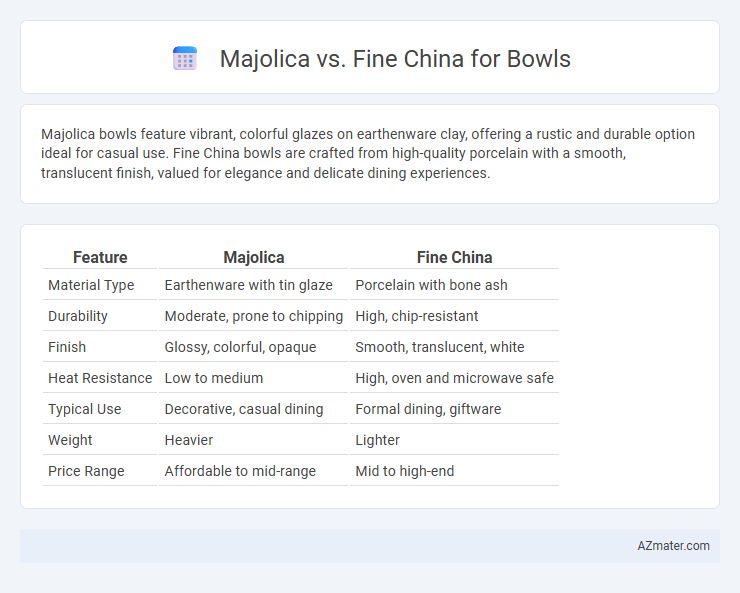Majolica bowls feature vibrant, colorful glazes on earthenware clay, offering a rustic and durable option ideal for casual use. Fine China bowls are crafted from high-quality porcelain with a smooth, translucent finish, valued for elegance and delicate dining experiences.
Table of Comparison
| Feature | Majolica | Fine China |
|---|---|---|
| Material Type | Earthenware with tin glaze | Porcelain with bone ash |
| Durability | Moderate, prone to chipping | High, chip-resistant |
| Finish | Glossy, colorful, opaque | Smooth, translucent, white |
| Heat Resistance | Low to medium | High, oven and microwave safe |
| Typical Use | Decorative, casual dining | Formal dining, giftware |
| Weight | Heavier | Lighter |
| Price Range | Affordable to mid-range | Mid to high-end |
Introduction: Majolica vs Fine China Bowls
Majolica bowls are known for their vibrant, hand-painted designs and sturdy earthenware composition, making them both decorative and practical for everyday use. Fine China bowls, crafted from delicate porcelain, offer a smooth, translucent finish with intricate patterns that emphasize elegance and sophistication. Choosing between Majolica and Fine China bowls depends on the desired balance of durability, aesthetic appeal, and intended use.
What is Majolica? Defining Characteristics
Majolica is a type of earthenware pottery distinguished by its vibrant, opaque tin-glaze that creates a glossy, colorful surface often decorated with intricate patterns or natural motifs. Unlike fine china, which is made from porcelain and known for its delicate translucency and durability, majolica features a heavier, more rustic texture and a distinctive hand-painted look. This style originated in the Renaissance period and remains popular for its artistic appeal and sturdy, tactile quality in bowls and other tableware.
What is Fine China? Key Features
Fine China is a type of high-quality porcelain known for its delicate, translucent appearance and exceptional durability, made from a refined clay mixture fired at high temperatures. Key features include its smooth, glossy finish, resistance to chipping and cracking, and intricate, often hand-painted designs that enhance its aesthetic value. Unlike Majolica, Fine China is non-porous and features a more elegant, lightweight build ideal for formal dining settings.
Historical Origins of Majolica and Fine China
Majolica originated during the Italian Renaissance in the 15th century, characterized by its vibrant tin-glazed earthenware technique that allowed for colorful, intricate designs. Fine China, developed in the early 18th century in England, traces its roots to the innovation of hard-paste porcelain, valued for its translucency, strength, and delicate appearance. Both materials reflect distinct cultural and technological advances in ceramic artistry, with Majolica emphasizing decorative glazing and Fine China highlighting refined porcelain craftsmanship.
Visual Differences: Color, Texture, and Design
Majolica bowls feature vibrant, hand-painted glazes with a glossy, often iridescent finish, creating a richly textured surface that emphasizes artistic, folkloric patterns. Fine china bowls exhibit a smooth, porcelain texture with a translucent quality, typically adorned with delicate, intricate designs in soft pastels or gold accents. The contrast lies in Majolica's bold, rustic color palette and tactile glazing versus fine china's refined, elegant aesthetic and subtle decorative motifs.
Durability Comparison: Everyday Use and Longevity
Majolica bowls are crafted from earthenware with a vibrant, lead-glazed finish that offers moderate durability suited for decorative use and light everyday tasks, but they are more susceptible to chipping and scratching compared to fine china. Fine china bowls, made from high-quality kaolin clay fired at higher temperatures, provide superior strength and resistance to thermal shock, making them ideal for frequent use and long-term durability. For everyday use, fine china bowls maintain their aesthetic appeal and structural integrity longer than majolica, which is better reserved for occasional or ornamental purposes.
Price Point: Affordability vs Luxury
Majolica bowls typically offer an affordable price point, making them accessible for everyday use and decorative purposes, often crafted with vibrant, artistic glazing techniques. Fine China bowls, on the other hand, are positioned as luxury items, characterized by high-quality porcelain, intricate designs, and a higher price reflecting craftsmanship and exclusivity. Consumers seeking budget-friendly options usually prefer Majolica, while those valuing elegance and prestige invest in Fine China.
Best Use Cases: Decorative vs Functional Bowls
Majolica bowls excel as decorative pieces due to their vibrant glazes and intricate hand-painted designs, making them ideal for display or serving dry items at casual gatherings. Fine china bowls, crafted from high-quality porcelain with delicate patterns, are best suited for functional use in formal dining settings where durability and elegance are prioritized. Choosing between Majolica and fine china bowls depends on whether the primary focus is aesthetic appeal or practical, everyday use.
Maintenance and Care Requirements
Majolica bowls require gentle hand washing with mild soap to preserve their vibrant colors and intricate glazes, as they are prone to chipping and crazing if exposed to harsh detergents or sudden temperature changes. Fine china bowls demand delicate care, including avoiding abrasive sponges and minimizing dishwasher use to maintain their translucent, smooth surfaces and prevent gold or platinum trims from fading. Both types benefit from cushioned storage to prevent scratches and chips, ensuring longevity and aesthetic appeal.
Conclusion: Choosing the Right Bowl for Your Needs
Majolica bowls offer vibrant, hand-painted designs with durability suitable for casual use and outdoor settings, while Fine China bowls provide a delicate, elegant finish ideal for formal dining and special occasions. Consider your lifestyle and usage frequency; opting for Majolica ensures everyday resilience, whereas Fine China caters to refined aesthetics and ceremonial purposes. Selecting the right bowl aligns with balancing practical functionality and desired visual appeal based on the setting and use.

Infographic: Majolica vs Fine China for Bowl
 azmater.com
azmater.com